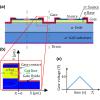当前位置:
X-MOL 学术
›
Phys. Rev. Appl.
›
论文详情
Our official English website, www.x-mol.net, welcomes your
feedback! (Note: you will need to create a separate account there.)
Interfacial Charge Dynamics in Metal-Oxide–Semiconductor Structures: The Effect of Deep Traps and Acceptor Levels inGaN
Physical Review Applied ( IF 3.8 ) Pub Date : 2020-01-07 , DOI: 10.1103/physrevapplied.13.014007 Y. Sharabani , Andrea Palmieri , Alexandros Kyrtsos , Masahiko Matsubara , Enrico Bellotti
Physical Review Applied ( IF 3.8 ) Pub Date : 2020-01-07 , DOI: 10.1103/physrevapplied.13.014007 Y. Sharabani , Andrea Palmieri , Alexandros Kyrtsos , Masahiko Matsubara , Enrico Bellotti

|
Using numerical simulations, we investigate the effects of deep traps and deep acceptor levels in magnesium-doped on interface charges in the semiconductor-oxide interface. Specifically, in this work we address two open issues observed in experimental studies on trench metal-oxide-semiconductor field-effect transistors. (i) We investigate the observed clockwise hysteresis in the transfer characteristics and elucidate the underlying physical mechanism causing it. By employing appropriate models for substitutional carbon at nitrogen sites () and nitrogen vacancies (), we calculate the hysteresis dependence on the trap concentrations and the measurement sweep duration . We show that acceptor traps in - are likely responsible for this phenomenon and the largest hysteresis is predicted for a sweep duration of . (ii) We also address the apparent inconsistency between the experimental and theoretically predicted magnesium-ionization levels and the variations of the measured transfer characteristics, specifically the threshold voltage. We show that the bands bending in the channel area creates a layer in which magnesium is completely ionized. As a result, the magnesium partial ionization does not have an effect and, while the threshold voltage decreases, nor does the breakdown voltage, as observed experimentally. The measured threshold voltage, which is lower than the theoretically predicted value, is caused by fixed and trapped charges at the interface, in agreement with values reported in the literature.
中文翻译:

金属氧化物-半导体结构中的界面电荷动力学:GaN中深陷阱和受体能级的影响
使用数值模拟,我们研究了镁掺杂中深陷阱和深受体水平的影响 半导体氧化物界面中的界面电荷。具体而言,在这项工作中,我们解决了以下实验研究中发现的两个未解决的问题:沟槽金属氧化物半导体场效应晶体管。(i)我们研究了在传输特性中观察到的顺时针方向磁滞现象,并阐明了引起这种现象的潜在物理机制。通过采用适当的模型来替代氮位上的碳()和氮空位(),我们计算了与陷阱浓度和测量扫描持续时间有关的磁滞现象 。我们证明 受体陷入 -- 可能是造成这种现象的原因,并且最大滞后时间预计为 。(ii)我们还解决了实验和理论上预测的镁电离水平与测得的传输特性(特别是阈值电压)变化之间的明显矛盾。我们表明,在通道区域弯曲的带会形成一层镁完全电离的层。结果,如实验观察到的那样,镁部分电离不起作用,并且尽管阈值电压降低,但击穿电压也没有。低于理论预测值的测量阈值电压是由界面处的固定电荷和俘获电荷引起的,与文献中报道的值一致。
更新日期:2020-01-07
中文翻译:

金属氧化物-半导体结构中的界面电荷动力学:GaN中深陷阱和受体能级的影响
使用数值模拟,我们研究了镁掺杂中深陷阱和深受体水平的影响 半导体氧化物界面中的界面电荷。具体而言,在这项工作中,我们解决了以下实验研究中发现的两个未解决的问题:沟槽金属氧化物半导体场效应晶体管。(i)我们研究了在传输特性中观察到的顺时针方向磁滞现象,并阐明了引起这种现象的潜在物理机制。通过采用适当的模型来替代氮位上的碳()和氮空位(),我们计算了与陷阱浓度和测量扫描持续时间有关的磁滞现象 。我们证明 受体陷入 -- 可能是造成这种现象的原因,并且最大滞后时间预计为 。(ii)我们还解决了实验和理论上预测的镁电离水平与测得的传输特性(特别是阈值电压)变化之间的明显矛盾。我们表明,在通道区域弯曲的带会形成一层镁完全电离的层。结果,如实验观察到的那样,镁部分电离不起作用,并且尽管阈值电压降低,但击穿电压也没有。低于理论预测值的测量阈值电压是由界面处的固定电荷和俘获电荷引起的,与文献中报道的值一致。











































 京公网安备 11010802027423号
京公网安备 11010802027423号